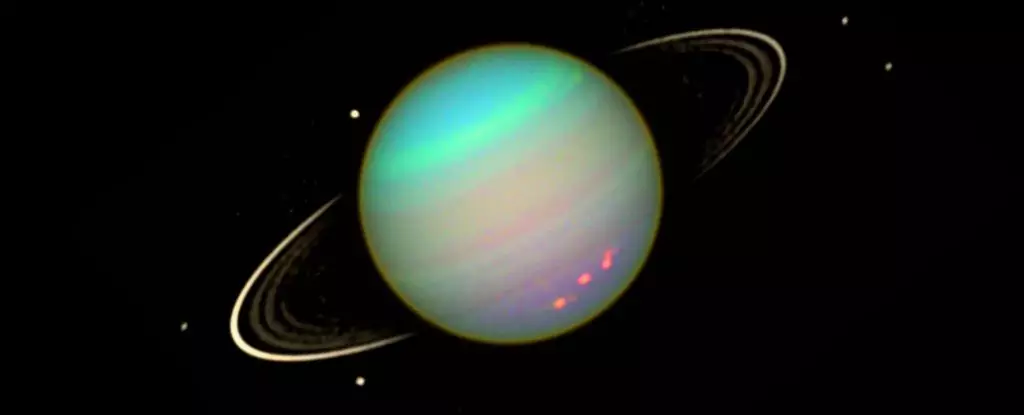Uranus stands out in the Solar System not just for its status as an ice giant, but for its strikingly peculiar characteristics. Unlike its planetary peers, whose axes of rotation align relatively perpendicular to their orbital planes, Uranus boasts an extreme axial tilt of 98 degrees. This bizarre orientation suggests a dramatic past, marked by catastrophic collisions that have likely played a role in tilting the planet. Furthermore, while most planets orbit the Sun in a prograde direction, Uranus exhibits a retrograde revolution, showcasing yet another layer of its uniqueness within our cosmic neighborhood.
Delving deeper into Uranus reveals an upper atmospheric layer known as the thermosphere-corona, which significantly differentiates this planet from others. At temperatures soaring above 500 degrees Celsius, the sources of heat within Uranus’ thermosphere have presented astronomers with a conundrum. As Voyager 2 provided the first detailed analysis of Uranus during its flyby in 1986, scientists have kept a close watch on temperature variations within the thermosphere over the decades. In an unexpected twist, recent observations indicate that the thermosphere’s temperature has halved since the Voyager flyby, a phenomenon that remains unfathomable, especially given that other planets have shown no equivalent cooling trends.
The intricacies within Uranus’ thermosphere are further augmented by the presence of an embedded ionosphere—a layer filled with H3+ ions. This ionosphere plays a crucial role in measuring thermosphere temperature, as it interacts dynamically with surrounding neutrals, reaching a state of thermal equilibrium. This interaction produces near-infrared (NIR) emissions that astronomers can analyze using ground-based telescopes, enabling them to gather insights about the thermosphere’s cooling amidst relative stability in the lower atmosphere.
One of the compelling puzzles in Uranus’ thermal behavior is that various seasonal phenomena and cycles of solar activity, such as the Sun’s 11-year solar cycle, have been conclusively ruled out as causal factors for its temperature decline. The persistence of this cooling trend challenges existing models of planetary atmospheres, forcing astronomers to rethink long-held beliefs about thermal dynamics and energy transfer in gas giants.
Recent investigations into the cooling of Uranus have implicated the solar wind as a primary agent. The solar wind, an incessant stream of charged particles from the Sun, interacts with planetary magnetospheres and has profound effects on their atmospheres. The findings suggest that the solar wind possesses a direct influence over Uranus’s thermosphere, a relationship that is unlike any observed at other planets in our Solar System. Researchers found that since 1990, there has been a noticeable decline in the solar wind’s outward pressure—this trend does not correlate directly with the solar cycle but seems to be linked intimately with the temperature shifts in Uranus’s upper atmosphere.
As a planet nearly 3 billion kilometers distant from the Sun, Uranus receives insufficient solar radiation to heat its atmosphere, unlike Earth, whose climate is innately tied to solar photons. Instead, the dynamics of Uranus appear influenced more heavily by varying solar wind interactions. This has led researchers to postulate that expansions in Uranus’s magnetosphere are restricting solar wind entry, thereby reducing the energy influx required to sustain a warmer thermosphere.
The unique thermospheric behavior of Uranus raises critical questions for future space missions, notably the proposed Uranus Orbiter and Probe (UOP) mission. This venture, identified as a top priority by the Planetary Science and Astrobiology Decadal Survey for 2023-2032, aims to delve into the mysteries of Uranus’s atmosphere. With fresh insights regarding solar wind’s effect, scientists are now challenged to refine the mission objectives: how does energy flow into Uranus’s magnetosphere, and what does it mean for our understanding of gas giant atmospheres?
The relevance of Uranus’s behavior is not confined to our Solar System. The cooling phenomenon, linked to solar wind interactions, could mirror atmospheres of exoplanets orbiting distant stars. For these worlds, the implications are significant: if a planet has a large enough magnetosphere, the stellar wind may dictate thermal conditions more than stellar radiation, much like the dynamics observed in Uranus.
Uranus not only compels astronomers to rethink established models of atmospheric physics but also encourages a broader examination of how planetary systems interact with their stellar environments. With potential ramifications for identifying habitable worlds beyond our Solar System, the enigmatic ice giant proves to be a cornerstone for future astronomical research, inviting new theories and inspiring a quest for knowledge well beyond our own cosmic backyard. It is this tantalizing blend of the known and the unknown that continues to captivate scientists and skywatchers alike, reminding us of the uncharted territories that still await discovery.


Leave a Reply